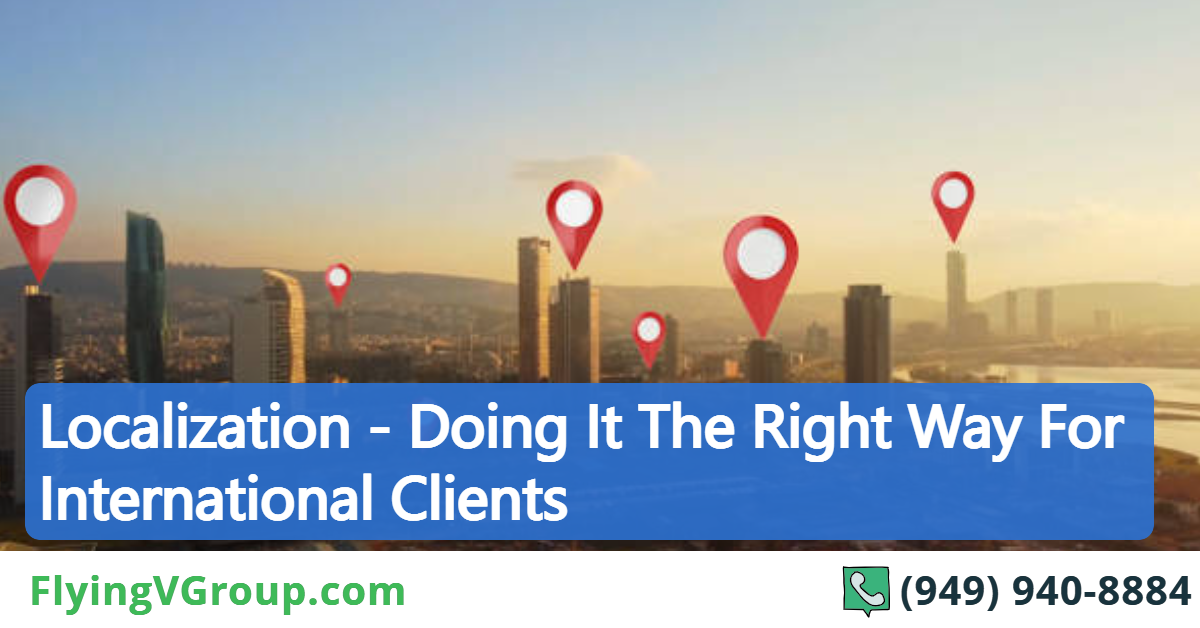Digital marketing has undergone several changes in recent times, and one of the massive trends is localization. Interestingly, this one is poised to become ever more prevalent going ahead.
Localization goes beyond merely translating website content. It is about building and forging emotional connections and bonds. The real questions are, ‘how legitimate is localization?’ ‘Can it help rank your website in the Google search engine?’ and ‘How can it help expedite SEO and boost results?’
What is a localization strategy, then? It involves customizing a product or information for local audiences.
Localization in International Campaigns
When it comes to a global marketing strategy, your brand needs to become appealing and relatable to the local audience.
So, what is the crux of localization? It is a dual-objective. In essence, the business focuses on being local while maintaining its macro or large-scale global appeal. The purposes are to raise awareness, enter new markets, and pitch to the correct audiences.
Content
The gamut of content is extensive, and it can mean several things. One way of attaining content localization is native language reviews on the website landing pages. Yet another is to convert currencies and provide local payment gateways and options. And adjusting the date and time formats is yet another.
But content cannot do without visual cues. Research posits that visuals can drive engagement levels and garner visibility. So, in sorting the local content, brands and businesses shall subscribe to user interfaces, lingos and even use relevant emojis that best suit the audience’s market. In this stead, the brand shall undergo a certain level of ‘transcreation’. In essence, this involves conveying the same message and concept in a new language. But, it goes beyond the mere replacement or translation of words. Transcreation entails bringing to the fore creativity and cultural knowledge.
Brands can perform localization marketing via:
- Operating local marketing campaigns in each market
- Deploying native content(regional or language-based websites and social media pages)
- Creating global campaigns with localization forming a part of it
SEO
Localization is also a ‘divide and conquer’ strategy. It can provide breathing space to marketing teams. Thus, creating time to generate large amounts of content.
So, what does localization mean for SEO and Conversions?
First up is enhanced keyword relevance and organic traffic. Content localization is a reflection of SEO. So, make sure to devote considerable work here! According to statistics, over 50 per cent of all Google search queries are performed in non-English languages. With that said, you will stand to lose out on oodles of traffic with non-localized content.
What’s more, the Google algorithm takes notice of your content localization efforts. This is shown by the “user localization update” that debuted in 2015. In translating and localizing the content, a unique set of keywords get added. And these phrases determine the locality for which you optimize the content.
So, target the localized keywords in the content. In this way, you will rank for them. Doing so shall also help your local SEO rank in the SERPs. And with good rankings, you will generate better traffic for localized search terms. If you want to see how international SEO plays out country by country, check out this article on Japanese SEO.
Secondly, content localization also helps generate higher conversions. About 86 per cent of localized messaging campaigns outperformed those of the English language. Also, 40 percent of users admit to not making purchases from websites not in their native language.
Advertisements
So, how does localization help with ads? They help bring out the context of the content and messaging. Ad content thus tends to have a wider reach and conversion potential than blog posts and other forms of written content. However, this needs to be localized and not generic. With that said, you must plan a geo-targeted context around the ad content. It is paramount that consumers relate to the messaging and comprehend the relevant context easily and conveniently.
To be effective, you must focus on enhancing the relevancy by adding geo-targeted images. Once done, the engagement metre shall automatically get driven up. Beware of out-and-out language or regional translations! These do not necessarily provide contextual relevance. A classic example is ‘stand out a mile’. Now, in English, this means obvious or easy to see. However, in another language, it might relate to the distance parameter. Hence, protect the correct context of your content and messaging. The other factors that merit consideration are currency and native phrases.
Another aspect of producing and writing ads is humanizing the brand messaging. Online users and visitors are humans. Be it awareness, visibility or conversions, ensure to humanize your content. Better yet, be a smart cookie and make the sharp-witted move of creating your ad around a core mission. Several brands indicate displaying support or awareness about a local cause or a social issue embedded in the region. This enables enterprises to hit those emotional chords with the audience. And note the objective – to traverse cultural differences with the ad.
What you can do here is:
- Use photos and images from the locality or region. You can go for random stock images and audience-specific imagery. Ensure that the chosen images convey human sentiment.
Connect or collaborate with local representatives and understand the nuances and texts of the local dialect. They can offer valuable insights into native phrases.
Integration Throughout the Customer Journey
While creating a good localization marketing strategy is paramount, it is not all. You also need to ensure that it works for you. To achieve this, you must look at the customer journey.
The first step is familiarisation. And this happens upon entering a new market. Here, localization needs to present your offering in the context of the region. And for this, you need to ensure that it happens at all levels – SEO, content, and advertisements. Once acquainted, the potential customers will do their due diligence in finding answers to their queries. This analysis and reflection shall happen online. So, make sure to have a Q&A section on your website. And above all, make sure it is in the native language since only after this shall one come to the decision – to buy or not to buy.
At FVG, our experienced team shall help overcome the nitty-gritty. They make the localization strategy seem seamless and quality-controlled. And how do we do this? We identify the local nuances and contexts and then work on local keywords and phrases. Once identified, we implement them in the website, email, social media posts and blog posts. We also gauge the local sentiment and any relevant social issues, making it our core mission and curating the ads around them. In that, we use phrases from the local dialect. This helps us enter the market with the correct footing. Second, it adds value to the local context by striking chords with the audience.
Our focus rests upon relevance, context and value. Volume, viewership and sales are the byproducts. We also conform to the local context and humanize our brand messaging.
At FVG, we are motivated towards helping you steer clear of questionable strategies by making the process as natural as possible. Trust us to be your best partners on the stairway to the skyline of success! Are you wondering where to begin?
Talk to us today and get ahead with your localization strategy.
SHARE THIS POST
Thank you so much for reading Localization – Doing It The Right Way For International Clients . We really appreciate it! If you have any questions about our article, or can suggest any other topics you think we should explore, feel free to let us know.
Be sure to sign-up for our newsletter to receive monthly emails on all of the latest trends and happenings in the digital marketing space. You will also receive our FREE E-Book with the Amazing Marketing Tools for Powerful Business Growth. Sign-up below!
Also, if you received some value out of this article, please share with your friends or colleagues, or leave a comment/question below. We really appreciate you reading our blog and every share/comment means the world to us and allows us to continue producing valuable tools to help you grow your business!






0 Comments